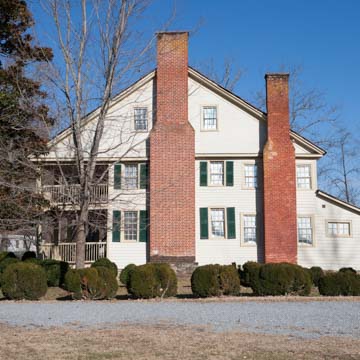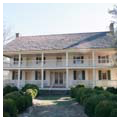Located in mountainous McDowell County, the Carson House is one of the area’s most impressive nineteenth-century houses. What was originally a modest mountain cabin grew into a Greek Revival structure as the Carson family became wealthy through land speculation in the western part of the state. Colonel John Carson was a Scots-Irish immigrant and a pioneer in the upper Catawba Valley. He became a representative to the Fayetteville Convention of 1789, where the U.S. Constitution was ratified by North Carolina. Three of Carson’s twelve children grew to become active in political affairs. When Carson’s youngest son, Jonathan Logan Carson, inherited the house in 1841, he expanded it to near its present form and operated it as an inn along a significant stage road to Asheville.
The house was built circa 1810 as a simple, one-room log structure adjacent to Buck Creek. Eventually, another one-room unit was added, along with a dogtrot to connect the two structures. When Jonathan Logan Carson inherited the property, he increased its size, constructing a two-story addition on the rear, resulting in a central passage plan two rooms deep beneath a new gable roof. He also added a deep, two-story porch that spanned the 60-foot-wide main facade. The five bays of the front facade are defined by six stacked columns. Two bays of windows flank the central entry doors on the main floor and a more modest door on the upper-level porch. The foundation is stone and the exterior walls are clad in painted wood siding. The interiors were finished with simple Greek Revival trim, most of which dates from the mid-nineteenth century. Somewhat later the dining room was painted gray with shades of red, blue, and brown to resemble marble. Two brick exterior chimneys, one in the center of the pediment and one towards the rear, are located on both gable ends.
During the Civil War, a small school for girls was housed here. By the war’s end, General Stoneman’s raiders had looted the house. When Jonathan Logan Carson died in 1887, the house and property were sold to John S. Brown and then to subsequent owners. On August 13, 1963, the Carson House Restoration Corporation bought the house and completed an extensive restoration. Since 1964, it has been open to the public as a historic house museum.
References
Bishir, Catherine W., Michael T. Southern, and Jennifer F. Martin. A Guide to the Historic Architecture of Western North Carolina. Chapel Hill: University of North Carolina Press, 1999.
Bishir, Catherine W. North Carolina Architecture. Portable edition. Chapel Hill: University of North Carolina Press, 2005.
Hill, Michael. “Carson House.” NCpedia. Accessed January 28, 2019. http://ncpedia.org/.
Zehmer, J. G., and Sherry I. Penny, “Carson House,” McDowell County, North Carolina. National Register of Historic Places Nomination Form, 1970. National Park Service, U.S. Department of the Interior, Washington, D.C.

















